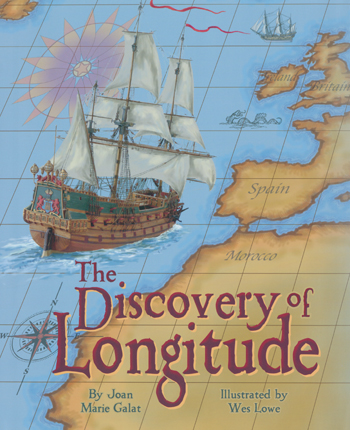| Discovery of longitude Author: Galat, Joan Marie | ||
| Price: $6.50 | ||
Summary:
The story of how carpenter John Harrison won the British government prize for building a clock accurate enough to calculate the necessary information to determine longitude for sailors.
| Illustrator: | Lowe, Wesley |
Common Core Standards
Grade 3 → Reading → RI Informational Text → 3.RI Key Ideas & Details
Grade 3 → Reading → RI Informational Text → 3.RI Craft & Structure
Grade 3 → Reading → RI Informational Text → 3.RI Integration of Knowledge & Ideas
Grade 3 → Reading → RI Informational Text → Texts Illustrating Complexity, Quality, & Range of
Grade 1 → Math → 1.MD Measurement & Data
Grade 2 → Math → 2.MD Measurement & Data
Reviews:
Kirkus Reviews (10/15/12)
School Library Journal (04/01/13)
Full Text Reviews:
School Library Journal - 04/01/2013 Gr 3–6—It is unclear who the target audience is for this picture-book history of the invention of the ship's clock. The text explains the difficulties of keeping accurate time on a ship and why it was essential. Unlike Louise Borden's Sea Clocks: The Story of Longitude (S & S, 2004), there is no biographical context given to inventor John Harrison's life and few pages are devoted to his work inventing and experimenting with clocks. The vague time line of Harrison's efforts at the end is more detailed than the text itself. There are some informative diagrams, but the lack of a glossary, index, or "detailed map of the world in the 1700s"-as promised on the book jacket-reduce the book's research value. It is unlikely that a middle-grade student would select this book voluntarily, though the relatively simple sentences, with unfamiliar words defined in context, and short paragraphs are conducive to independent reading. The strongest facet is the paintings of life at sea that appear on every page, but they are not enough to merit inclusion in most collections. Borden's book as well as Kathryn Lasky's The Man Who Made Time Travel (Farrar, 2003) are still the go-to titles on this topic.—Rebecca Dash Donsky, New York Public Library - Copyright 2013 Publishers Weekly, Library Journal and/or School Library Journal used with permission.



